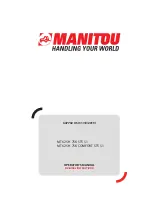
Figure 50
1. Drain plug
7. Remove the drain plug and allow the oil to
drain into the pan (Figure 50).
8. When finished, install and tighten the drain
plug.
Note:
Dispose of the used oil at a certified
recycling center.
9. Fill the hydraulic tank with approximately 12
US gallons (45.4 l) of 10W-30 detergent, diesel
engine oil (API service CH-4 or higher); refer
to Checking Hydraulic Fluid in Operation,
page 18.
10. Start the engine and let it run for a few minutes.
11. Stop the engine.
12. Check the hydraulic fluid level and top it off if
necessary; refer to Checking Hydraulic Fluid
in Operation, page 18.
13. Close the hood.
Checking the Hydraulic
Lines
After every 100 operating hours, check the
hydraulic lines and hoses for leaks, loose fittings,
kinked lines, loose mounting supports, wear,
weather, and chemical deterioration. Replace all
moving hydraulic hoses every 1500 hours or 2
years, which ever comes first. Make necessary
repairs before operating.
Hydraulic fluid escaping under pressure
can penetrate skin and cause injury. Fluid
injected into the skin must be surgically
removed within a few hours by a doctor
familiar with this form of injury or gangrene
may result.
•
Keep your body and hands away from
pin hole leaks or nozzles that eject high
pressure hydraulic fluid.
•
Use cardboard or paper to find hydraulic
leaks, never use your hands.
Cleaning
Removing Debris from the
Traction Unit
Important:
Operating the engine with
blocked screens, dirty or plugged cooling fins,
and/or cooling shrouds removed, will result in
engine damage from overheating.
1. Park the traction unit on a level surface, lower
the loader arms, and stop the engine.
2. Remove the key and allow the engine to cool.
3. Open the hood.
4. Clean any debris from the front and side
screens.
5. Wipe away debris from the air cleaner.
6. Clean any debris build-up on the engine and in
the oil cooler fins with a brush or blower.
Important:
It is preferable to blow
dirt out, rather than washing it out. If
water is used, keep it away from electrical
items and hydraulic valves. Do not use
a high-pressure washer. High-pressure
washing can damage the electrical system
and hydraulic valves or deplete grease.
7. Clean debris from the cooler fan grill on the
hood.
8. Close the hood.
40
Summary of Contents for 22306
Page 8: ...Slope Chart 8...
Page 11: ...108 4670 108 4671 93 9084 1 Lift point 2 Tie down point 11...
Page 46: ...Schematics Electrical Schematic Rev A 46...
Page 47: ...Hydraulic Schematic Rev A 47...
Page 48: ......
Page 49: ......
Page 50: ......






























